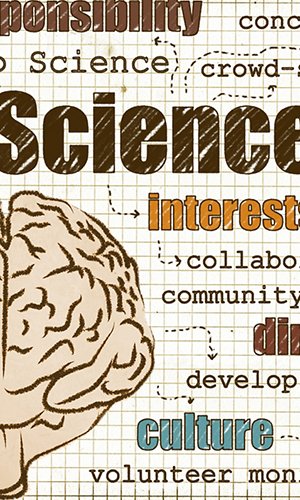Do you remember the game called “Chinese whispers”? All the participants had to stand in line and the game started with the first player whispering a word or a sentence in the ear of the person standing next to him. The player than repeated the sentence to the player next to him in line, and so on right up to the last player in the line who had to repeat the sentence aloud. It was a source of much fun, because most of the times the sentence was repeated wrong, due to an accumulation of mistakes in the transmission along the line. Just like in this game, also in everyday life, a lot of information is reported incorrectly, due to different interpretations of the facts related by the various interlocutors. One of the greatest and most frequent problems that scientists must face is the difficulty in communicating with those who do not belong to the sector: the country of Leonardo Da Vinci and Galileo Galilei continues to show a certain amount of incomprehension with regard to science and researchers. As in the case of Chinese whispers, at a time when the world of research wants to communicate with the general public, often incomprehension and misunderstanding arise, at times it is because of the media, at times it is because of the difficult topics that are being dealt with that cannot be simplified for non-experts.
Many ideas, in fact, have left the world of science and have made their way into our everyday vocabulary, although unfortunately these are almost always used incorrectly. In this way, the world of research is misunderstood, and this creates a growing gap between what scientists want to say and what is reported by the newspapers and TV news broadcasts.
Among these, one of the most widespread terms is the word “theory”.
Voice search

What language does science speak?
Theory
It is quite common, in fact, to associate the word “theory” with an “idea” or “an assumption”.
Actually, scientific theories are entire systems of ideas that can be verified, and that can potentially be contradicted with proof at hand, or through tests. In 1962, the scientist Thomas S. Kuhn published a book, which has become one of the most important texts on the philosophy and history of science of the 20th century, called “The structure of scientific revolutions”. According to Kuhn, theories are based on scientific results that are universally recognized, that provide models and solutions for a determined community of scientists for a period of time: paradigms. These core principles are applied in order to explain the mechanisms and the problems that arise in understanding the world around us, and every time they are applied effectively , their correctness is reconfirmed. With the passing of time, these theories can however show some anomalies that are tied to the difficulty scientists face in applying them to phenomena outside the models of the paradigm. In this case the basic assumptions of the reference theoretical framework are questioned, and all the aspects that make it wrong are examined. An example of this is when we observe the sun. Up to 1500, observing the positions of the sun and the moon in the sky, it was a common belief that the earth was the centre of the universe (first paradigm: geocentric theory). This model provided a sufficiently good explanation of the movement of the heavenly bodies that were observed, and it complied with the cosmological vision of the Sacred Scriptures, besides being coherent with the common feeling (affirmation of the paradigm which remains the same: geocentrism). During the course of the centuries, some philosophers (e.g. Aristarchus, Heraclites) proposed the hypothesis that the rotation of the stars could be apparent and due to the Earth’s movement (difficulty in applying the paradigm to the contemporary problem). Based on scientific knowledge of the times, however the theories were contradicted. With the progress of technologies and knowledge, later, a Polish astronomer called Nicolaus Copernicus (whose name the Copernican Revolution derives from) described the motion of the celestial bodies, placing the Sun as the centre of the universe, and thus proving the theories proposed by the Greek philosophers where it was not the celestial bodies to rotate around the earth, but the sun was in the centre of the planet orbits system (changed paradigm: heliocentric theory).
With the variations in the requirements and knowledge, the technological solutions, just like the theories, were affected by changes which at times were quite radical. This does not mean that the previous ideas were always totally wrong, but only that they were based on knowledge and technologies that were less advanced than the present ones. Therefore, based on new proofs, new theories are formulated that explain all the conditions in which the old system failed. Some scientific theories, elaborated in the 19th and 20th century (among which Evolution, Special Relativity and Quantum Mechanics) are still considered correct today. However, in this context, we should add a few details.
Proof
“Proof” in the scientific sense, is perhaps the concept that has been most misunderstood of all the terms used in the scientific field. It has a technical definition: it is “the act or process of deriving logical conclusions from premises known or assumed to be true”, and this is greatly in contrast with how it is used in casual conversations, where the meaning is more similar to, simply, “a strong evidence of something”. There is therefore a discrepancy between what the scientists state and what the people are able to gather, because researchers tend to have a much stronger, well-outlined and precise definition in mind. From the definition that is commonly used, science does not prove much! So when the question is asked, “ What is the proof that we have evolved from other species?” or “Can it be proved that climate change is caused by human activities?” according to the term that is commonly used, we tend to hesitate, rather than answer with self-assurance, “Of course we can, the fact that science is constantly evolving is one of the key aspects of its efficacy”. By improving and updating the “old” paradigms, in fact, science develops theories that are more and more reliable and complete about the world. The concept of proof, in the scientific sense, is therefore very strong and it faces a great setback when considered “only a theory”. When stated in this way, it is implied that scientific theory is not much, if not supported by scientific data and tests. This is truly far from reality. At times we hear the exclamation “Ah, but it is only a theory!” with regard, for example, to the Theory of Evolution. On the contrary, however, there are apparently no doubts about Isaac Newton’s Theory on Gravity, when trying to fly in the sky like Superman. In other words, the term “theory” in the scientific sense is very different from the term that is commonly used in the sense as “an idea”. It often occurs that these terms are used erroneously and together with these, another term that is misunderstood in common everyday language is the adjective “chemical”.
Chemical and synthetic
Some weeks ago, in fact, at the supermarket, I was standing in front of the shelves with the sweeteners, when I heard a discussion between two young people about which type of vanillin to buy.
“Which one do you think I should buy?”
“Choose the natural one! The extract from vanilla pods, because the chemical one is harmful! The natural one, theoretically, is healthier!”.

The Vanilla flower on plantation
It is common, in fact, to use the adjective “chemical” to indicate all that is “synthetic” and therefore of industrial origin or manmade. In most cases it is a negative trait of the substance it is attributed to.
But, what is chemistry? The definition of chemistry is, “a science, or more precisely a branch of natural science that studies the composition of matter and its behaviour depending on the said composition”. Therefore, according to the definition, everything is chemical. But then, what did the young person at the supermarket mean? Let us examine the real differences between what is defined “chemical” (i.e. “synthetic”) and what is defined “natural” more in detail, taking vanillin that we find at the supermarket as an example. Vanillin of “natural origin” (i.e. extracted from vanilla pods) contains the vanillin molecule together with a series of other molecules that are present in very low percentages, with a very similar taste which is however slightly different. This slight difference is not greatly felt by our taste buds except as “hints of…” as food experts often state.
Synthetic vanillin, instead, is created in a laboratory starting with other molecules, and the end product is the identical molecule found in the vanilla pods, and with an identical taste. The only difference is that all the surrounding molecules, in very low percentages, mentioned by the critics, are not present, because the producer synthesizes only that specific molecule and not the others. The only difference between these two molecules therefore lies in the effort to produce or to extract them.
It is as if we were buying a house, and included in the price there was a beautiful garden and a wooden fence, painted white, all around or if, we were buying the identical house, with the garden, but without the fence. Buying the wood boards and white paint we could build the same fence with the only difference that in the first case it was built by someone else, the carpenter or the vanilla plant, while in the second case we need to build it ourselves. What’s the difference, if not the effort? Furthermore the product synthesized by man, is pure, and is therefore particularly suited for those with any intolerance or allergy to one of the surrounding compounds that are present in very small percentages and that would therefore prevent their use. This is the case of vanillin and also all the other synthetic products.
In 2007, Mrs. Mayu Yamamoto was awarded the Ig Nobel prize (given to those strange, amusing and even absurd researches, which however stimulate the public’s interest in science, medicine and technology) for having extracted vanillin from cow dung, thus proving that, notwithstanding the scarce utility of the research which in fact made her win the prize, the molecule becomes exactly the same as the one extracted from the plant.
In fact we can think of any molecule as a set of Lego bricks. For example, if we join them together, in a certain order we can build a car. If we break up the bricks of the car, we can re-use the bricks, for example to build a house. In the same way, the molecules (the house or the car) are made up of atoms (the various bricks). And just as we break up and then join together the Lego bricks, we can break up and join together the molecules obtaining molecules that are exactly identical to the “natural” ones.
Only if we know the true meaning of scientific terms, can we have a more correct opinion of what takes place around us, and decide with greater awareness what to purchase and what to think of a determined fact without being conditioned by any bias or by the wrong opinions of others.
Actually these are only some of the terms which have acquired a different meaning from their original one. In the next Special Report we will examine other terms which, like in Chinese whispers, have gained a totally new meaning, as they spread from mouth to mouth.
Edited by Davide Poli



